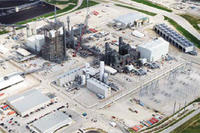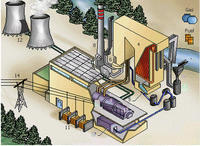-
High-altitude wind energy shows promise
Wind turbines hovering high in the air and tethered to the ground, like kites, have the potential to generate huge amounts of electricity, based on a recent wind availability study. Researchers pinpointed tracts of the atmosphere ideal for locating airborne wind energy (AWE) devices, which convert kinetic energy from wind into electricity. Recently published research shows that there are enough areas usable by airborne turbines to produce several terawatts of electric power annually — more than enough needed to meet worldwide demands. More than twenty companies are developing various versions of the technology, with over 100 related patents filed in the United States alone.
-
-
Making ethanol without corn or other plants
Ethanol today is produced at high-temperature fermentation facilities that chemically convert corn, sugarcane, and other plants into liquid fuel. Growing crops for biofuel, however, requires thousands of acres of land and vast quantities of fertilizer and water. In some parts of the United States, it takes more than 800 gallons of water to grow a bushel of corn, which, in turn, yields about three gallons of ethanol. Stanford scientists have created a copper-based catalyst that produces large quantities of ethanol from carbon monoxide gas at room temperature.
-
-
Debate over closing NY’s Indian Point nuclear power plant intensifies
Indian Pointnuclear power plant, just thirty miles from New York City, has presented a conundrum for environmentalists who advocate clean-air initiatives, caps on carbon emissions, and increasing investment in non-polluting renewable energy sources — but at the same time argue that nuclear power poses a safety hazard to the surrounding area and demand that Indian Point cease operations. Closing the plant would require a long-term energy strategy to replace the 2,000 megawatts the plant currently produces.
-
-
Scale model WWII-era plane flies with fuel from the sea

U.S. Navy researchers demonstrated proof-of-concept of novel technologies developed for the recovery of carbon dioxide (CO2) and hydrogen (H2) from seawater and conversion to a liquid hydrocarbon fuel. Fueled by a liquid hydrocarbon — a component of NRL’s novel gas-to-liquid (GTL) process which uses CO2 and H2 as feedstock — the research team demonstrated sustained flight of a radio-controlled (RC) P-51 replica of the legendary Red Tail Squadron, powered by an off-the-shelf (OTS) and unmodified two-stroke internal combustion engine.
-
-
More stringent climate policies mean hard choices for coal plant operators
Limiting climate change to 2°C means shutting down coal power plants — an unpopular proposition for coal power companies. A new study shows, however, that delaying climate policies could prove even worse for power plant owners. The reason: new power plants being built now, especially in China and India, are built to run for 30-50 years, paying off only after years of operation. Stringent climate policies, however, could make the cost of emission so high that coal power generation is no longer competitive, leaving new power plants sitting idle and their owners and investors with huge losses — a problem known as stranded capacity.
-
-
The costs of using wind energy, natural gas for electricity virtually equal
The costs of using wind energy and natural gas for electricity are virtually equal when accounting for the full private and social costs of each, making wind a competitive energy source for the United States, according to a new study on the federal tax credit for wind energy. The analysis shows that wind energy comes within .35 cents per kWh when levelized over the 20-year life of a typical wind contract, compared on an equivalent basis to the full costs for natural gas-fired energy.
-
-
Russia leads, U.S. lags in construction of nuclear power reactors around the world
Has a new cold war developed between Russian and the United States in the twenty-first century? Many argue that it has — but with a more unconventional front of commercial nuclear energy contracts with developing countries. Russian companies are building 37 percent of new nuclear reactors around the world; U.S. companies build only 7 percent of new nuclear facilities.
-
-
World record in high altitude wind turbine set to be broken
Boston, Massachusetts-based Altaeros Energies, a wind energy company formed out of MIT, said its Alaska demonstration project is set to break the world record for the highest wind turbine ever deployed. The $1.3 million, 18-month project will deploy the Altaeros BAT at a height 1,000 feet above ground. At that height, the BAT commercial-scale pilot project in Alaska will be over 275 feet taller than the current record holder for the highest wind turbine, the Vestas V164-8.0-MW. Investment into the high altitude wind sector has recently gained momentum with several large acquisitions.
-
-
New insight into improved wave energy testing
Scientists have studied how wave energy developers can more accurately measure and predict the wave conditions within wave energy test sites. The researchers deployed wave measurement buoys and used wave modelling to show how variations in wave size and strength could be resolved.
-
-
Controversial Mississippi power station to cut emissions by more than half

A new $5 billion state-of-the-art power facility is under construction Kemper County, Mississippi. It places a firm bet on the future of carbon-capture technology, and other technological advancements, including: it utilizes the gasification process with carbon in unique ways; it recycles treated wastewater to generate power; and it makes money from the carbon dioxide it has removed by selling it to oil companies for their own extraction. Critics say that investing so much money in untested technologies is too much of a gamble.
-
-
Shale may offer long-term home for nuclear waste
About 77,000 tons of spent nuclear fuel currently sit in temporary above-ground storage facilities, and it will remain dangerous for tens or hundreds of thousands of years or longer. Experts say that since the U.S. government abandoned plans to develop a long-term nuclear-waste storage site at Yucca Mountain in Nevada in 2009, finding new long-term storage sites must be a priority. Shale deep under the Earth’s surface could be a solution. France, Switzerland, and Belgium already have plans to use shale repositories to store nuclear waste long-term.
-
-
Methane from Deepwater Horizon oil spill has entered food web

When millions of gallons of oil spilled into the Gulf of Mexico four years ago, so did large volumes of methane, or natural gas. Now, researchers have confirmed that methane-derived carbon has entered the Gulf’s food web through tiny organic particles floating in the Gulf. The presence of methane is not cause for alarm though, the researchers said. Overall, it has a benign impact on the food that makes it from the sea to people’s dinner tables.
-
-
Libyan PM escapes country after assembly ousts him over oil tanker fiasco
Libya’s General National Congress has approved a no-confidence motion against Prime Minister Ali Zeidan and designated the defense minister as acting prime minister. Zeidan left Libya after the vote, in all likelihood for Italy. The no-confidence vote came after a North Korean-flagged tanker named Morning Glory managed to sail away from the port of al Sidra, carrying 234,000 barrels of crude oil from rebel-held oil fields. Last summer, armed militias in east Libya took over most of the country’s oil fields – and also three ports, with partial control of a fourth — bringing oil exports, which had amounted to 1.6 million barrels a day, to a halt. U.S. describes oil sale by the militias as “theft” from the Libyan people.
-
-
East Europe’s natural gas networks vulnerable during conflicts and crises
Gas networks in Eastern European countries, such as Ukraine and Belarus, are less resilient than the U.K. gas networks during conflicts and crises, according to new research. The authors suggest that a decentralized approach to managing congestion on gas pipeline networks could be crucial for energy security during geopolitical conflicts or natural disasters, for example.
-
-
Small biomass power plants could help rural economies, stabilize national power grid

As energy costs rise, more Americans are turning to bioenergy to provide power to their homes and workplaces. Bioenergy is renewable energy made from organic sources, such as biomass. Technology has advanced enough that biomass power plants small enough to fit on a farm can be built at relatively low costs. Researchers have found that creating a bioenergy grid with these small plants could benefit people in rural areas of the country as well as provide relief to an overworked national power grid.
-
More headlines
The long view
Trump Is Fast-Tracking New Coal Mines — Even When They Don’t Make Economic Sense
In Appalachian Tennessee, mines shut down and couldn’t pay their debts. Now a new one is opening under the guise of an “energy emergency.”
Smaller Nuclear Reactors Spark Renewed Interest in a Once-Shunned Energy Source
In the past two years, half the states have taken action to promote nuclear power, from creating nuclear task forces to integrating nuclear into long-term energy plans.
